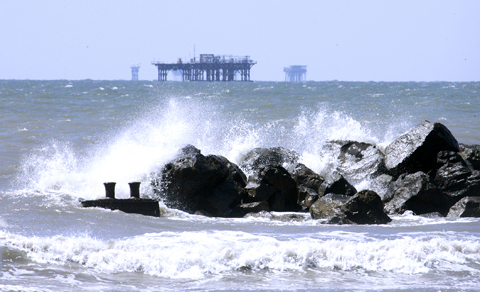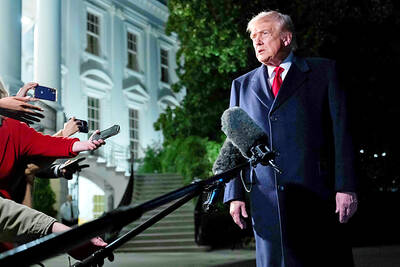The booming oil hub called Port Fourchon, a nerve center in the US’ oil supply chain, is turning into a sitting duck for hurricanes as the beach that protects it from the Gulf of Mexico washes away.
The 5km-long sand bank — blasted last year by hurricanes Gustav and Ike, and by Katrina and Rita three years before that — is nearly all that keeps the Gulf from thrashing the pipelines and shipyards that handle 15 percent of all crude oil flowing to inland refineries.
Port Fourchon, about 112km south of New Orleans, also supports 90 percent of the Gulf’s 3,700 offshore platforms and connects with the Louisiana Offshore Oil Port — the only US port capable of handling the largest oil tankers. The offshore port handles 1.5 million barrels of oil a day and ties in by pipeline to about half of domestic refining capacity.

PHOTO: AP
Officials worry that unless work begins immediately to bolster the port’s defenses, a direct hit from a strong Category 3 storm or worse could wipe out its waterways, docks, giant cranes, tanks and helipads, crippling the facility for weeks and creating a national energy crisis overnight.
The Army Corps of Engineers hopes to begin work in 2011 on a shoreline restoration project for the Caminada Headland, where Port Fourchon sits.
But this month and next month are the most active months, and catastrophic storms are not unheard of even during the sleepiest of seasons.
“Hope and pray there’s not another hurricane before we can get out there and do the work,” said Fay Lachney, the corps’ project manager.
Beyond the potential energy crisis, a badly damaged Port Fourchon poses an environmental risk, said Wilma Subra, a Louisiana chemist and environmental activist. On a survey after Gustav last year, Subra found the area littered with hazardous debris from rigs, ships and oil and gas facilities.
An environmental catastrophe isn’t likely though, since the port is not a major storage spot for oil and pipelines typically are emptied when a storm threatens.
Port officials are eager for the corps work to begin but say they need to immediately shore up the facility’s eastern flank with US$20 million of improvements. So far, the port has not been able to raise money for breakwaters, man-made dunes and other protection. The Federal Emergency Management Agency has said it does not pay for damage to a natural beach, and a proposal to use stimulus funds was rejected.
Chett Chaisson, the port’s economic development director, said he was trying to raise US$10 million in state, port and local funds, and that he would turn to the energy industry “if we come up short ... if we can’t find funding through the normal sources.”
Mike Lyons, a lawyer for the Louisiana Mid-Continent Oil and Gas Association, said the energy industry has done a great deal to stop erosion in Louisiana.
“There’s quite a bit of money coming in from the industry’s operations assisting in the state’s efforts to do coastal restoration work,” Lyons said.
The industry’s biggest direct contribution to Port Fourchon came when Chevron spent US$500,000 on beach restoration at the port in the early 1990s, Chaisson said. More recently, Shell helped plant vegetation on a new manmade ridge.
For now, about all the people who run the port can do is watch the sand wash away. Port staff patrol the area looking for breaches and erosion, dispatching reports to state and federal agencies, pleading for action.
“Every storm, the beach rolls back. We’re getting to a critical point now,” Chaisson said. “We keep telling that story and the money just doesn’t come.”
For its part, the Gulf is not procrastinating.
A recent patrol cruised past a nearly meter-long redfish skeleton bleached by the sun, then came to an abrupt halt. A new breach blocked the way.
“This is bad,” port police officer Mitchell Hohensee said.
A couple of weeks before, he’d driven by with no problem. “I’m going to have to get the GPS coordinates for this one,” he said.
GPS coordinates help map the site. Also, Hohensee said, the Coast Guard would need to know if a pipeline running through the area had been exposed.
Last year’s storms washed away about 30m of beach on the Caminada Headland, leveled dunes and breached the beach
Once the waters breach the beach, it creates a tidal prism: water flows between the Gulf and the body of water behind the beach, the breach growing larger with time.
It’s possible the breaches will fill in on their own, as has happened before but the long-term combination of erosion, storms and breaches may be too much.
The land on which the port sits is already isolated, reachable only by the narrow two-lane road to the mainland that often floods.
Work is continuing on a new elevated road to keep the outpost connected as Louisiana’s coastline continues receding.
“We know that the port is going to be a little island out there in the water that you have to get to by an elevated highway,” Chaisson said.
But, he said, “if it totally goes, this country has a big problem ... It’s much cheaper to protect this port than it is to try and build it somewhere else.”

People can preregister to receive their NT$10,000 (US$325) cash distributed from the central government on Nov. 5 after President William Lai (賴清德) yesterday signed the Special Budget for Strengthening Economic, Social and National Security Resilience, the Executive Yuan told a news conference last night. The special budget, passed by the Legislative Yuan on Friday last week with a cash handout budget of NT$236 billion, was officially submitted to the Executive Yuan and the Presidential Office yesterday afternoon. People can register through the official Web site at https://10000.gov.tw to have the funds deposited into their bank accounts, withdraw the funds at automated teller

PEACE AND STABILITY: Maintaining the cross-strait ‘status quo’ has long been the government’s position, the Ministry of Foreign Affairs said Taiwan is committed to maintaining the cross-strait “status quo” and seeks no escalation of tensions, the Ministry of Foreign Affairs (MOFA) said yesterday, rebutting a Time magazine opinion piece that described President William Lai (賴清德) as a “reckless leader.” The article, titled “The US Must Beware of Taiwan’s Reckless Leader,” was written by Lyle Goldstein, director of the Asia Program at the Washington-based Defense Priorities think tank. Goldstein wrote that Taiwan is “the world’s most dangerous flashpoint” amid ongoing conflicts in the Middle East and Russia’s invasion of Ukraine. He said that the situation in the Taiwan Strait has become less stable

REASSURANCE: The US said Taiwan’s interests would not be harmed during the talk and that it remains steadfast in its support for the nation, the foreign minister said US President Donald Trump on Friday said he would bring up Taiwan with Chinese President Xi Jinping (習近平) during a meeting on the sidelines of the APEC Summit in South Korea this week. “I will be talking about Taiwan [with Xi],” Trump told reporters before he departed for his trip to Asia, adding that he had “a lot of respect for Taiwan.” “We have a lot to talk about with President Xi, and he has a lot to talk about with us. I think we’ll have a good meeting,” Trump said. Taiwan has long been a contentious issue between the US and China.

FRESH LOOK: A committee would gather expert and public input on the themes and visual motifs that would appear on the notes, the central bank governor said The central bank has launched a comprehensive redesign of New Taiwan dollar banknotes to enhance anti-counterfeiting measures, improve accessibility and align the bills with global sustainability standards, Governor Yang Chin-long (楊金龍) told a meeting of the legislature’s Finance Committee yesterday. The overhaul would affect all five denominations — NT$100, NT$200, NT$500, NT$1,000 and NT$2,000 notes — but not coins, Yang said. It would be the first major update to the banknotes in 24 years, as the current series, introduced in 2001, has remained in circulation amid rapid advances in printing technology and security standards. “Updating the notes is essential to safeguard the integrity